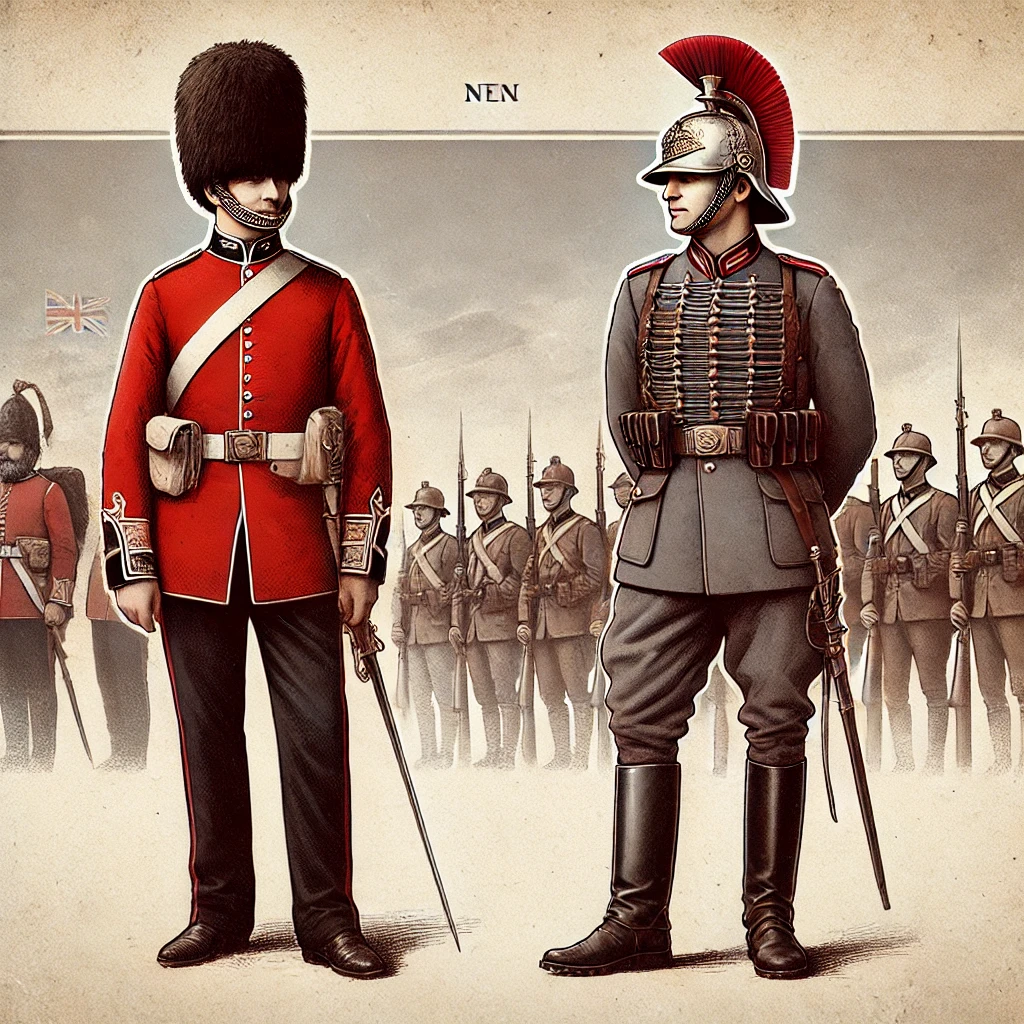
The Evolution of Victorian British and German Military Uniforms in the 19th and 20th Centuries
Published on Mar 08, 2025
The Evolution of Military Uniforms: British and German Regiments in the 19th and Early 20th Centuries
Introduction
Military uniforms have long been a symbol of national pride, discipline, and the evolving nature of warfare. The 19th and early 20th centuries were pivotal periods that saw significant transformations in military attire, reflecting technological advancements, tactical shifts, and cultural influences. This article delves into the distinctive uniforms of British regiments during the Victorian era. It sheds light on the key figures and companies responsible for outfitting the German army in the early 1900s.
Victorian British Army Uniforms: A Reflection of Tradition and Change
The Victorian era (1837–1901) was a time of profound change for the British Army in terms of structure and appearance. Uniforms during this period were functional and served as a visual representation of a regiment's history and status.
Infantry Uniforms
The standard attire for British foot soldiers in the early 1800s consisted of scarlet coatees paired with white trousers. However, by the 1840s, dark blue trousers became the norm for winter wear, offering better practicality and durability. The iconic red coats, symbolizing British military prowess, remained a staple, though their designs evolved over the decades.
Headgear also underwent notable transformations. The "stovepipe" shako, a tall cylindrical hat, was prevalent during the early 1800s. In 1812, the "Belgic" shako, characterized by its raised front, was introduced. By 1844, the Albert shako, named after Prince Albert, debuted. This design featured a lower crown tapered inward at the top and included a rear peak to shield the neck from the sun. Despite its innovative features, the Albert shako faced criticism for being heavy and uncomfortable, leading to its eventual replacement in 1855.
Cavalry and Specialized Units
Cavalry regiments showcased a diverse array of uniforms, each reflecting their unique roles and traditions:
- Hussars: Recognized for their elaborate attire, hussars donned braided jackets known as dolmans, accompanied by fur-lined pelisses draped over one shoulder. Their headgear typically included busbies—high, cylindrical fur hats adorned with plumes.
- Dragoons and Dragoon Guards: These units wore plumed helmets and tailored jackets, exuding elegance and intimidation.
- Rifle Regiments: Operating as skirmishers, rifle regiments opted for dark green uniforms to blend seamlessly with natural surroundings, a stark contrast to the bright red of line infantry.
Transition to Khaki
The challenges faced during the Second Boer War (1899–1902) highlighted the impracticality of bright uniforms in modern warfare. The conspicuous scarlet made soldiers easy targets, prompting a shift towards more subdued colors. By the early 1900s, khaki service dress became standard, offering better camouflage and marking a significant departure from traditional bright uniforms.
German Military Uniform Production in the Early 1900s
As Europe approached the 20th century, Germany emerged as a formidable military power. This ascendancy necessitated efficient and large-scale production of military uniforms, leading to the prominence of several key manufacturers.
Hugo Boss
Founded in 1923 by Hugo Ferdinand Boss in Metzingen, Germany, the company initially specialized in producing shirts and jackets. With the rise of the Nazi Party, Hugo Boss's firm became a significant supplier, manufacturing uniforms for various Nazi organizations, including the SA, SS, and Hitler Youth. The company's involvement during this period has been the subject of extensive historical examination.
Carl Halfar Uniformen-Mützen Fabrik
Established in 1890 by Carl Halfar, this Berlin-based company specializes in crafting military visors and caps. By the 1930s, it had become one of the primary suppliers for the German army and Nazi organizations, including the Afrika Korps and the Luftwaffe. The company's products were integral to the German military's identity during this era.
Uniform Design and Functionality
German military uniforms in the early 1900s were characterized by meticulous design, reflecting both tradition and the demands of modern warfare:
- M1907/10 Tunic: Introduced before World War I, this field-gray tunic became the standard for German infantry. It featured a stand-and-fall collar, turned-back cuffs, and pleated pockets, balancing functionality with the sharp appearance typical of German military attire.
- Headgear: The iconic Pickelhaube, a spiked leather helmet, was widely used during the early 1900s. However, its limitations in trench warfare led to adopting the Stahlhelm (steel helmet) in 1916, offering improved protection and becoming a symbol of the German soldier.
Influence of Tailors and Textile Manufacturers
Military uniforms were not just products of government contracts but also skilled tailors and textile manufacturers. British and German uniform production involved numerous specialists who ensured quality and consistency.
British Military Outfitters
British military uniforms were traditionally supplied by renowned firms such as:
- Henry Poole & Co. – This Savile Row tailor was known for outfitting officers with high-quality dress uniforms.
- Gieves & Hawkes – Established tailors who supplied ceremonial and everyday military wear for British officers and regiments.
German Military Tailors
Germany's military uniform production in the early 1900s was supported by textile industries in regions like Saxony and Bavaria. Skilled artisans and factories were crucial in producing mass quantities of field uniforms while ensuring a distinct and structured appearance.
Conclusion
The evolution of military uniforms during the 19th and early 20th centuries reflects broader societal, technological, and tactical changes. While British uniforms symbolized a balance between tradition and practicality, German uniforms displayed precision in function and design. The transition from bright, elaborate uniforms to more practical, camouflaged attire marked a significant shift in military fashion, shaped by the realities of modern warfare. Understanding these changes provides valuable insights into military history and the enduring legacy of these iconic uniforms.
